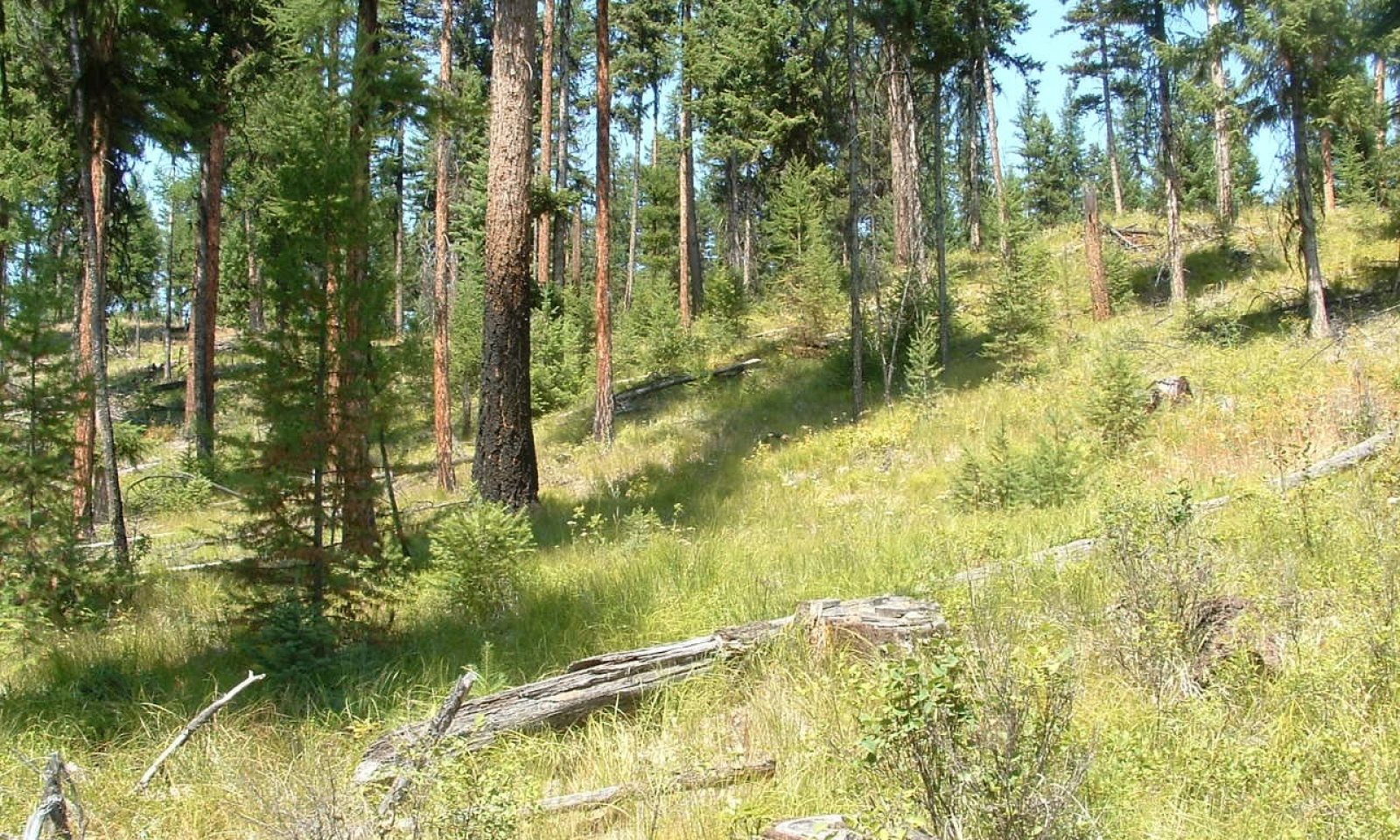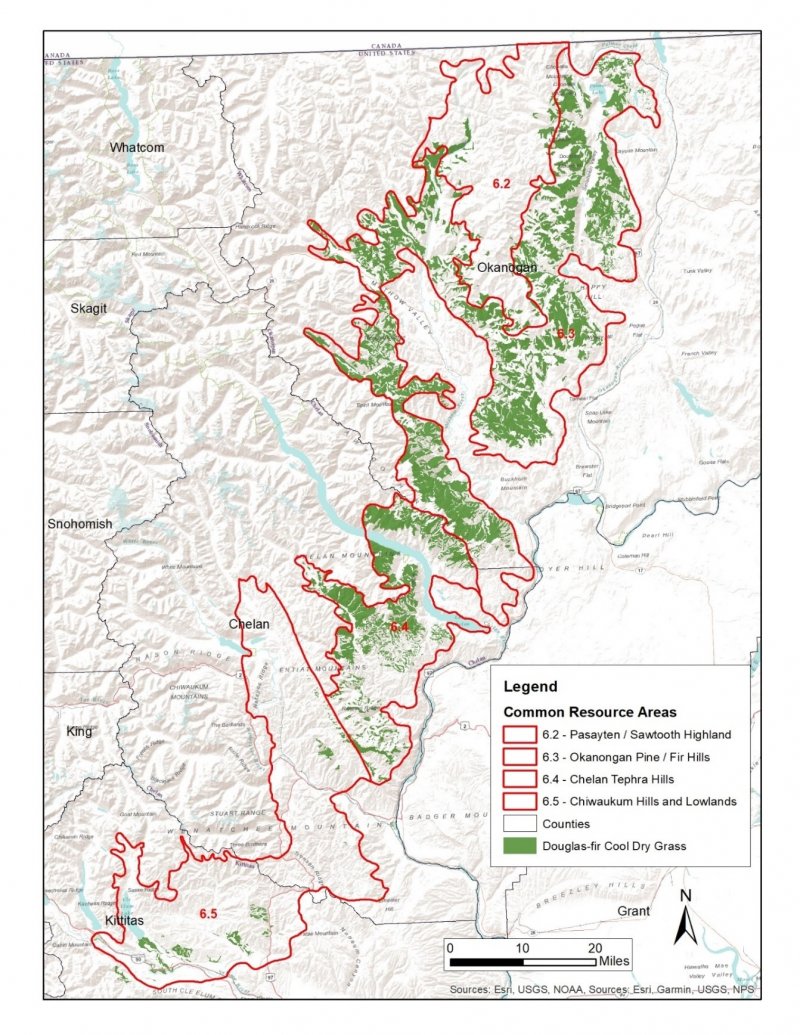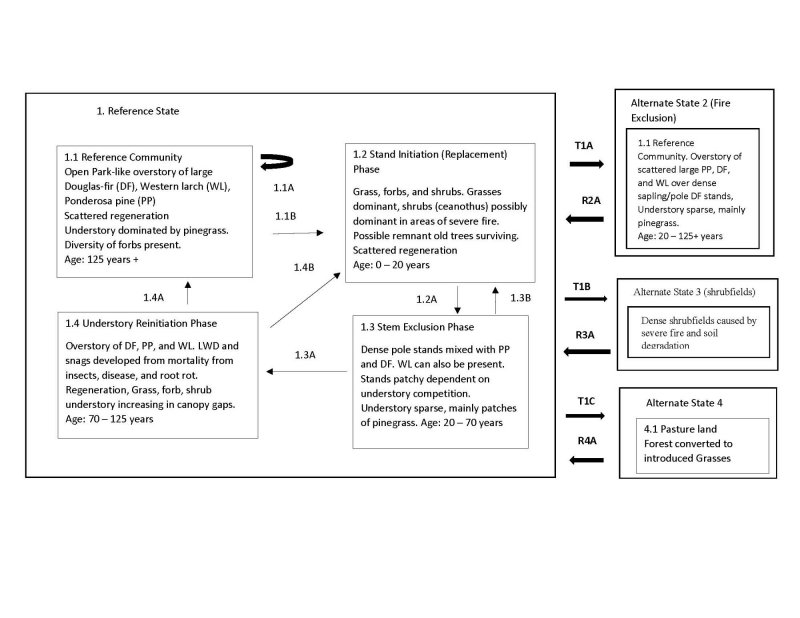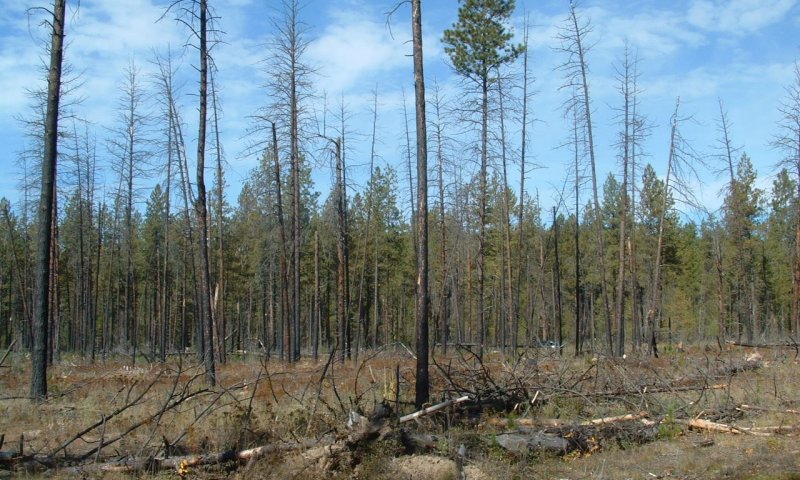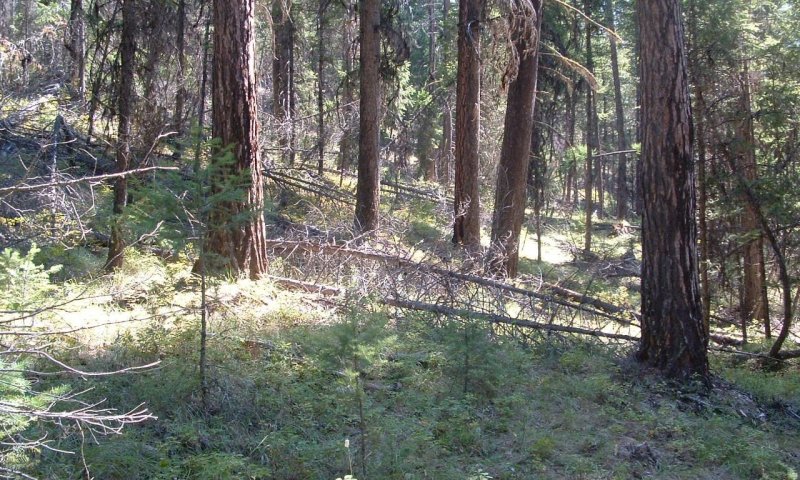Ecological dynamics
Open park-like stands of large diameter Douglas-fir, western larch and ponderosa pine with a pinegrass dominated understory. Frequent low severity ground fires every 10-20 years kept understory natural tree establishment low and maintained pinegrass cover. Overstory tree composition depends on seed source and moisture conditions. Douglas-fir and western larch dominate stand composition with low percentages of ponderosa pine depending on site disturbance. On the warmer portions of this site at lower elevations ponderosa pine will be dominate with scattered Douglas-fir and western larch. This site occurs on southern exposures or ridgetops at higher elevations (4000 - 5000 feet) and on flats or outwash plains with cool air drainage at lower elevations. Most of the soils are granitic or glacial till with a volcanic ash cap. Lodgepole pine can be present in overstory and understory depending on seed source and cool air drainage conditions and fire occurrence. Fire exclusion has cause natural regeneration to advance from seedling to high density pole stands underneath the larger older trees creating ladder fuels and increased potential for stand replacing fire capable of causing mortality to the older large diameter overstory. Douglas-fir is susceptible to budworm and tussock moth defoliation during drought years. Dwarf mistletoe can be present in Douglas-fir and western larch.
This ecological site encompasses 4 Douglas-fir plant associations incorporated into the Douglas-fir Cool Dry Grass biophysical group:
Douglas-fir/pinegrass, Douglas-fir/bearberry/pinegrass, Douglas-fir/pachistima/pinegrass, and Douglas-fir/bitterbrush/pinegrass.
The most dominant is the Douglas-fir/pinegrass association. It is located north of Lake Chelan in CRA 6. This ecological site is based on this plant association. The Douglas-fir/bearberry/pinegrass association occurs in the west area of CRA 6.3 and eastern half of Lake Chelan in CRA 6.4. The Douglas-fir/pachistima/pinegrass association occurs in the southern area of CRA 6.3 just north of Lake Chelan. The Douglas-fir/bitterbrush/pinegrass association occurs in the western portion of CRA 6.3 in close proximity to the DF/bearberry/pinegrass association.
The main difference ecologically in these 4 plant associations is the occurrence and abundance of western larch and shrub species. In the DF/pinegrass and DF/bearberry/pinegrass associations western larch is common in the overstory and can regenerate after disturbance. In the DF/pachistima/pinegrass and DF/bitterbrush/pinegrass associations western larch is absent or minor. Ponderosa pine is common in all these plant associations. Another main difference is understory species abundance. In the DF/pinegrass association pinegrass dominates the coverage. The other 3 plant associations there is more abundance and coverage of shrubs with pinegrass.
These shrub/pinegrass associations were included in the DF Cool Dry Grass Ecological site as they are cooler than the DF/shrub/bluebunch wheatgrass associations and react similar to the main DF/pinegrass association in regards to disturbance, with the exception of western larch absence.
State 1
Reference
Reference plant community phase consists of park-like stands of large diameter Douglas-fir, western larch, and ponderosa pine. Understory is dominated by a continual sward of pinegrass. Tree regeneration is scattered. Frequent ground fires every 10-15 years cause mortality in established seedlings/saplings, mainly Douglas-fir creating sites for new seedling establishment, and perpetuate the pinegrass understory. Fire severity is low as to not cause mortality to large diameter overstory. USFS habitat type and plant association publications recognize this site as Douglas-fir/pinegrass. Douglas-fir is the dominant tree species, however, with frequent fire western larch and ponderosa pine will dominate the larger overstory. In warmer areas, western larch is absent or occasionally found in openings, and ponderosa pine becomes the major species with Douglas-fir. Also, in these warmer areas shrubs such as bearberry, pachistma, spirea, serviceberry, snowberry, bitterbrush and ceanothus spp. are abundant.
Fire exclusion has caused of this site to have high density stocking of the second level overstory from regeneration growing into pole to mature stands. This ladder fuel site condition has high potential for stand replacing fire even killing the larger older overstory.
Major insects that can cause mortality are the fir engraver, western spruce budworm, and Douglas-fir beetle. The Douglas-fir tussock moth can also cause concern. Drought and dense stands developing from prolonged fire intervals enhance beetle attack and tree mortality. The western pine beetle and the mountain pine beetle can cause mortality in ponderosa pine. Dwarf mistletoe is a major concern in western larch causing major growth loss and mortality. It will also be found on Douglas-fir, ponderosa pine, and lodgepole pine. Dwarf mistletoe was found in over 40% of the acreages in the Eastern Cascades where Douglas fir was a major stand component. Again, dense stands underneath infected trees from prolonged fire intervals causes mistletoe to spread easier. Fuel loads and ladder fuels increase fire intensity as a result.
Other diseases include Annosum, laminated, and Armillaria root rots. These root rot diseases are enhanced through soil compaction and root damage though selective logging and road building.
Forage production estimates from NRCS Range 5 Plots in Okanogan County in DF/pinegrass sites are as follows based on overstory tree canopy. Forage production figures are in pounds/acre for all vegetation below 4.5 feet (grass, sedges, forbs, shrubs, tree regeneration):
Overstory tree canopy – Forage production
0 – 20% - 800 to 1200 lbs/ac
20 – 40% - 600 – 800 lbs/ac
40 – 70% - 400 – 600 lbs/ac
70+% 0 – 400 lbs/ac
The bulk of the grass production was pinegrass and Idaho fescue. Small percentages of sedge and bluebunch wheatgrass were recorded. The most prominent forbs were lupine, basalmroot, pussytoes, and hawkweed. Shrubs included currant, snowbrush ceanothus, spirea, snowberry, kinnikinnik, and rose spp. Tree regeneration included Douglas-fir and ponderosa pine.
Dominant plant species
-
Douglas-fir (Pseudotsuga menziesii), tree
-
lodgepole pine (Pinus contorta), tree
-
western larch (Larix occidentalis), tree
-
kinnikinnick (Arctostaphylos uva-ursi), shrub
-
Oregon boxleaf (Paxistima myrsinites), shrub
-
white spirea (Spiraea betulifolia), shrub
-
russet buffaloberry (Shepherdia canadensis), shrub
-
snowbrush ceanothus (Ceanothus velutinus), shrub
-
Saskatoon serviceberry (Amelanchier alnifolia), shrub
-
Cascade barberry (Mahonia nervosa), shrub
-
common snowberry (Symphoricarpos albus), shrub
-
antelope bitterbrush (Purshia tridentata), shrub
-
bluejoint (Calamagrostis canadensis), grass
-
Ross' sedge (Carex rossii), grass
-
Geyer's sedge (Carex geyeri), grass
-
bluebunch wheatgrass (Pseudoroegneria spicata), grass
-
heartleaf arnica (Arnica cordifolia), other herbaceous
-
common yarrow (Achillea millefolium), other herbaceous
-
white hawkweed (Hieracium albiflorum), other herbaceous
-
silky lupine (Lupinus sericeus), other herbaceous
-
arrowleaf balsamroot (Balsamorhiza sagittata), other herbaceous
-
Scouler's woollyweed (Hieracium scouleri), other herbaceous
Community 1.1
Open Park-like
Park-like widely spaced 125+ year old overstory of Douglas-fir, western larch, and ponderosa pine with understory dominated with pinegrass. Tree regeneration scattered and sporadic. Frequent ground fires every 10-20 years cause tree regeneration to be low. Overstory tree species composition dependent on seed source and moisture spectrum of site. Cooler moister locations have more Douglas-fir and western larch. Ponderosa pine dominate drier locations and have an increased understory cover of kinnikinnik.
(Restoration to open overstory through tree removal and understory burning.)
Resilience management. 1.1A – Frequent low intensity ground fires maintain open stand and pinegrass understory
Community 1.2
Stand Replacement
Stand replacing fire creates a grass and potential shrub dominated site. Pinegrass will dominate the site and potentially snowbrush ceanothus shrub species can dominate in some areas where fire was severe. Severe fire damage to soil can cause ceonothus shrub fields for many years causing site to go to Alternative State 3. In low or mix severity fires natural regeneration will be sporadic depending on seed source and plant competition.
Community 1.3
Stem Exclusion
Natural regeneration growing to the pole stage can consist of Douglas-fir, western larch, and ponderosa pine. Lodgepole pine can also form dense stands depending on seed source and cool air drainage areas. Lack of sun on forest floor due to tree crown density understory is sparse with sprigs of pinegrass scattered. When tree canopy thins from competition, management, insects/disease, windthrow, and/or fire, pinegrass will rapidly increase in coverage.
Community 1.4
Understory Reinitiation
Overstory starts to thin out or gaps created by insect/disease mortality or windthrow allowing understory to develop. Snags and large woody present. Pinegrass and forbs increase and regeneration of Douglas-fir can occur.
Pathway 1.1B
Community 1.1 to 1.2
Stand replacement fire caused by weather patterns prolonging fire return interval allowing tree regeneration layer to grow into sapling/pole stands creating ladder fuels.
Pathway 1.2A
Community 1.2 to 1.3
Time, fire interval extended to allow regeneration to grow into pole stands.
Pathway 1.3B
Community 1.3 to 1.2
Stand replacing fire
Pathway 1.3A
Community 1.3 to 1.4
Time, low fire intensity, pole stands survive into mature stand, scattered mortality occurs from competition, insects, and disease.
Pathway 1.4A
Community 1.4 to 1.1
Time, with mix severity and low severity fires opening up stand.
Pathway 1.4B
Community 1.4 to 1.2
Stand replacing fire
State 2
Fire Exclusion
Since European settlement the fire regime has changed greatly reducing frequent low intensity ground fires that kept these forests more open, with reduced tree density and more resilient to severe intensity fires. In addition, years of hygrading (harvesting largest best trees on site), overgrazing, prevalence of many roads which create fire breaks, and tree plantations has created a different forest structure. Dense multi-layered forests of Douglas-fir underneath larger old pine, fir and larch now exist. Dense stands of understory Douglas-fir can have over 1000 stems per acre. This creates extensive ladder fuel conditions which lead to the potential for stand replacing fires.
Community 2.1
Multi-Storied Stand
Scattered overstory of large old Douglas-fir, western larch and ponderosa pine with dense stands of Douglas-fir underneath. This plant community is a risk of severe stand replacing fire capable of killing the larger old overstory. Intensive fuel load reduction is needed to open up sites in this condition followed by using prescribed fire.
Community 3.1
Shrubfields
Severe stand replacing fire causing duff and organic matter to be destroyed negatively affecting soil fertility. Ceanothus species, especially shiny leaf ceanothus, dominates the site for 50+ years. This shrub species can grow in low nitrogen soils caused by intensive hot fires. Tree regeneration nonexistent to sporadic not capable to reclaiming site.
Community 4.1
Pasture Conversion
A portion this ecological site has been converted to pasture using introduced grasses like orchard grass. Restoration would include intensive site preparation and tree planting followed by prescribed fire in future when trees more resistant to fire damage.
Transition T1A
State 1 to 2
Fire exclusion allowing regeneration to develop underneath old overstory.
Transition T1B
State 1 to 3
Shrubfields caused by severe fire and soil degradation.
Transition T1C
State 1 to 4
Forest converted to pastureland .
Restoration pathway R2A
State 2 to 1
Time, intensive tree removal of second level DF stand followed by prescribed burning
Restoration pathway R3A
State 3 to 1
Careful selection of sites to determine if tree planting success is warranted.
Restoration pathway R4A
State 4 to 1
Intensive tree establishment practices followed by prescribed burning when trees more fire resistant.
